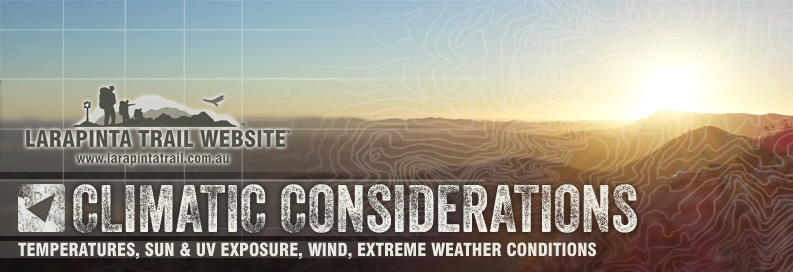 |
 |
| The Larapinta Trail is located in Central Australia, an arid region with extreme climatic conditions of intense heat and freezing conditions. Choosing the right time to walk the trail is vital, not only for your own enjoyment and leisure, but also your health and safety. Winter offers the best and most ideal walking conditions with low-mid 20C temperatures, cool breezes and cold, sometimes freezing nights. Rain does fall in the region throughout the year, sometimes in downpours. Always check the forecasts before walking the trail. |
|
 Key Points Key Points |
|
 |
Best time to walk the Larapinta Trail: May - August |
 |
Worst time to walk the Larapinta Trail: October -
January |
 |
Ideal time to walk the Larapinta Trail: June-July |
 |
Temperatures can vary up to 20 degrees C in 24 hours |
 |
Temperatures can drop below freezing in winter |
 |
Temperatures can rise to the high forties in summer |
 |
UV exposure levels are very high to extreme |
 |
It does rain in Central Australia, sometimes in downpours causing flooding |
|
|
 |
Winter Considerations |
| Winter is the best time to walk the Larapinta Trail. There are clear blue skies, low-mid 20C temperatures and cool breezes - ideal walking conditions. Nights are often quite cool. It is not uncommon for frequent 3-5C nights, particularly in the gorges and valleys. Temperatures can drop below freezing (see below) during winter. |
| Key Points |
 |
Low-mid 20C temperatures and cool breezes |
 |
Frequent 3-5C cool nights, particularly in gorges, valleys |
 |
Temperatures can vary up to 20 degrees C in 24 hours |
 |
Clear blue skies. High UV and exposure |
 |
Temperatures can drop below zero degrees C |
|
 |
 |
Summer Considerations |
| Summer in the Red Centre ( and along the Larapinta Trail) is characterised by intense heat ( mid 40's C), hot winds, low humidity and high UV. On the Larapinta Trail these temperatures are often more intense because the surface temperature is significantly higher due to the heat captured and generated by the rocky mountain ranges. |
| Key Points |
 |
Extreme heat ( mid 40's C) during the day, very warm nights |
 |
Extreme exposure to UV radiation |
 |
Very low humidity and very dry air/wind |
 |
Surface temps are often 5-8 degrees C hotter than air temps |
 |
Rain is most likely dui ring summer months |
|
 |
 |
Freezing Considerations |
| Freezing temperatures are not uncommon on the Larapinta Trail, particularly in the months of June or July. Temperatures can drop below 0C and has been known to drop down to -7C. Frost can also occur and is not uncommon. See our blog for more information. |
| Key Points |
 |
Temperatures can drop to zero and below |
 |
Frosty nights are common during winter |
 |
Temperatures have dropped down to -7C |
 |
Temperatures can vary up to 20 degrees C in 24 hours |
 |
Freezing conditions most likely in gorges, valleys & low areas |
|
 |
 |
Rainfall |
| Rain in Central Australia (and along the Larapinta Trail) is not uncommon and can occur any time of the year. All Larapinta Trail hikers should prepare for wet weather, particularly drizzle which can last for days. Heavy rain, while not common during winter, can and does flood rivers and creek lines. Heavy rains earlier in the year are a good indicator that hikers should expect 'wet crossings' of waterhole's and creeks, particularly in gorges. |
| Key Points |
 |
Mean annual rainfall is 284mm |
 |
Rain can occur anytime in the year |
 |
Rain in winter is mostly drizzly and can last for a few days |
 |
Heavy rain can flood rivers, creeks and waterhole's |
 |
Heavy summer rains often mean likely wet crossings in winter |
|
 |
|
 |
Wind Considerations |
| Wind is quite common along the Larapinta Trail particularly on high ground, in valleys and along ridgelines and saddles. Camping on high ground without windy conditions is uncommon, so expect incessant wind for most of the nights. Wind chill considerations are also important, particularly during the colder months. Note that wind also contributes to dehydration. |
| Key Points |
 |
High ground is often windy, sometimes continuously |
 |
Valleys, ridgelines, saddles & gorges can also be 'wind tunnels' |
 |
Wind contributes to dehydration, particularly dry wind. |
 |
Camping on high ground will likely be windy and noisy |
 |
Wind chill is a factor of consideration on the Larapinta Trail |
|
 |
 |
UV and Sun |
| Sun and clear skies are almost constant throughout the year with an average of 20-25 days of sun each month. UV exposure during the day is almost 100% even when its cloudy. Exposure to sun and its effects are one of the most important considerations for walkers particularly in regards to dehydration, sun burn and heat exhaustion. |
| Key Points |
|
 |
|
|
 |
| A typical winter afternoon shot on the Larapinta Trail - cloudless blue skies, sun & cool |
|
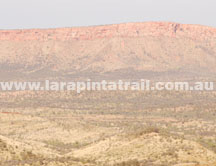 |
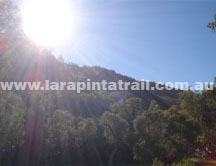 |
| Summer on the trail can feel like a furnace |
|
| Sun & UV exposure on the trail is constant |
|
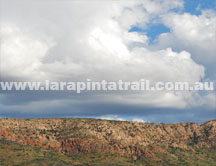 |
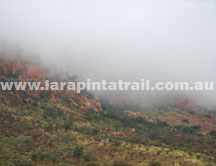 |
| The prelude to rain on the trail: Heavy clouds |
|
| Rain can occur anytime of the year |
|
 |
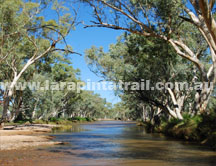 |
| Freezing nights are not uncommon |
|
| Good rain fills creeks quickly |
|
More images   |
|
 |
|
|
|
|
 |
|
